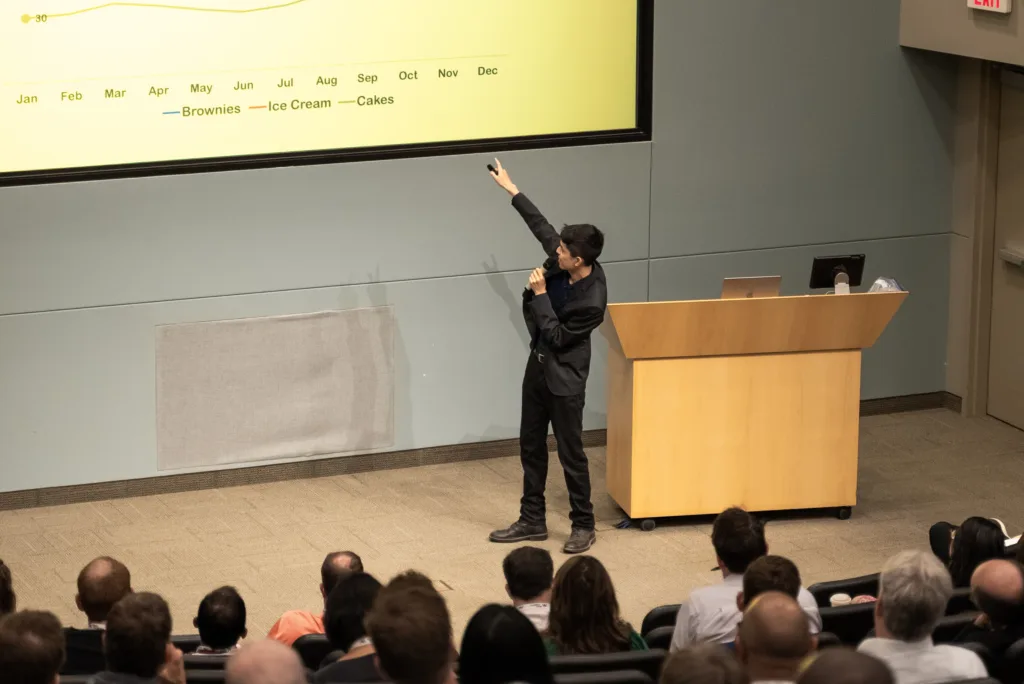We measure the success of our products and technology all the time.
- Was the launch successful? Check user adoption
- Was the website update successful? Check user conversion.
- Was the algorithm successful? Check the accuracy…or a plethora of other available metrics
But rarely do we measure the success of our presentations.
In this article I’d like to overview the metrics you should NOT use to measure how “good” your presentation is, and the one simple metric you should consider using.
- First, it’s not about the quantity of information
- Second, it’s not about a perfect delivery
- Third, it’s not (always) about the outcome
- A clear presentation is a successful one
- Summary
First, it’s not about the quantity of information
One pitfall many presenters fall into is thinking a presentation is about giving information. It’s not. It’s about giving your audience an experience.
As an analogy, why do people go to concerts when all the same music is available on YouTube? They can get the same information for free and from the comfort of their home! People go to concerts because they want the experience of listening to their favorite performer live.
That’s the same reason why people attend your presentations. Your boss could get the same information from an email or written report. They sit and listen to you because they want an easy, simple, guided experience of the information from someone they trust.
The metric of success is therefore not quantity of information or information/min, since writing is the optimal vehicle for that, not presentations.
What then should the metric be? How should it be based on “experience”?
Second, it’s not about a perfect delivery
Another pitfall presenters fall into is thinking they have to be flawless in front of the camera or in front of the meeting room. They worry a slight stammer, loose “um”, or overlong pause will destroy their credibility.
That couldn’t be further from the truth.
To continue the concert analogy, imagine you attend a concert by your favorite performer. They’re singing your favorite song and suddenly the guitar string snaps just as they get to the best part.
Would that ruin your experience?
Yes – if the performer dwells on the moment. If they look around in dismay, shake their head, and stop the concert, you will be justifiably upset at their “mistake”.
But if they throw the broken guitar across the stage, grab a backup one and just keep going where they left off, that probably will feel like the coolest moment of your concert-going life.
Especially in our world increasingly dominated by AI-generated images and videos and text, I want you to remember this: perfection feels fake. People embrace the imperfections that make us relatable, and will cheer you on if you confidently keep moving forward.
So if the goal isn’t to increase information/min or decrease mistakes/min, what should it be? This is where things get tricky…
Third, it’s not (always) about the outcome
In business, the goal of a presentation is not to inform and not to speak perfectly. It’s to inspire people to actually do something based on our information: to donate money, or purchase the product, or sign-off on the proposal. Business succeeds when actions are taken, and that’s what presentations are for.
The natural conclusion would then be:
- The presentation is a success if the action is taken
- Or the presentation is a success if X% of people in the audience took the action
I agree with this, to an extent.
For simple calls to action that require very little effort from the audience like downloading a resource or donating $1 to an important cause, it’s easy to measure success in this way:
- Right after the presentation or for X days after, see how much money was donated or how many resources were downloaded.
- If it hit or exceeded your goal, you win!
But consider more high stakes calls to action like requesting a large investment in your startup or trying to convince an executive to purchase an expensive new software platform. If they don’t say “yes”, do you consider your presentation a failure?
I argue no. Consider this:
- Your content, delivery, and research into your audience might have been perfect.
- But something unexpected might have happened and they now lack the budget.
- Or something unexpected happened and now this isn’t the right time to buy.
Those factors are completely out of your control. So does that mean you failed?
No, and that’s why I believe the best metric of presentation success is: Clarity
A clear presentation is a successful one
If you’re crystal clear in your content and delivery, you’ve succeeded in giving them a great experience. Because while your high stakes call to action might not be taken now, it will be considered in the future if you follow-up well.
And clarity is in your control. If you do your due diligence to research an audience and their needs, and put in the effort to prepare and rehearse, you know exactly how to be clear. You will understand exactly what language, examples, and stories to use to address their pain points and move them to action.
How then do you measure clarity? Three possibilities:
Least effort
Throughout a presentation, assess the questions your audience asks:
- If a large portion of their questions ask you to clarify what you mean or what the point you’re trying to make is, there’s a high likelihood you were not clear.
- On the other hand, if their questions are oriented around how to use your idea to do X, Y, or Z, you know you were clear because they want to take your idea to the next level.
For more tips on effective listening in the workplace, read more here.
Medium effort
After a presentation, ask members of the audience how clear you were:
- Don’t say: “How was it?” (Because people are rarely completely honest giving feedback if you’re the one asking them)
- Say: “What was most memorable for you?” (People will answer this honestly – and if the thing they remember most is the point you were trying to make, you know you were clear)
- As a bonus, ask your audience a few days after the presentation to see what they remember. That makes it even more clear what points of yours were able to stick.
Most effort
Before a presentation, send a survey to your audience assessing what they know. After the presentation, send a survey to your audience assessing what they learned:
- If they gained the insight or perspective change you hoped for, then you were clear.
- As a bonus, you can give quizzes or polls throughout a presentation to see how clear you are in the moment, and adjust accordingly.
A successful presentation is a clear experience.
For a science-based approach to constructing great presentations, read more here.
Summary
We should assess the success of our presentations just like we assess the success of our products and technology.
The metric for presentation success should not be:
- Quantity of Information (Too much information and you overwhelm the audience)
- Perfection of Delivery (An imperfect delivery can still be successful if you handle it with grace and keep moving forward)
The metric for presentation success should not (always) be:
- Whether Action Was Taken (Action is a highly desirable byproduct of presentation success. But whether our audience takes action is not in our control, especially for high-stakes actions that might require more time and money to finalize)
The metric for presentation success should be:
- Whether You Were Clear (If the audience understands your point and remembers it, you’ve achieved your goal. And the action you want them to take can be re-assessed when the time is right)
If you’re looking for further guidance on how to speak with confidence and authority, reach out to me here.



